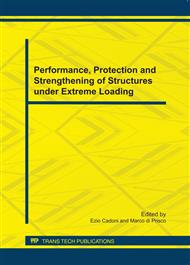p.473
p.479
p.485
p.491
p.497
p.503
p.509
p.515
p.521
The Effect of Anchorages on FRP Strengthening of RC Walls to Resist Blast Loads
Abstract:
In this paper, the effectiveness of strengthening reinforced concrete (RC) walls with fiber reinforced polymer (FRP) bonded to RC wall with epoxy, or with epoxy plus additional boundary anchors, or distributed anchors to resist blast loads is studied. Both the bonding and anchorage strengths are modeled in numerical simulations. FRP and anchor debonding failures are modeled in the simulation. Based on numerical results, pressure-impulse (P-I) diagrams of FRP composite strengthened RC walls are generated using numerical analyses. The results show that the RC wall strengthened with FRP and anchors displays an increase in the impulse and pressure asymptote of the P-I curve as compared to those strengthened with FRP only, indicating that placing anchors to prevent FRP debonding or peeling-off increase the RC slab load carrying capacities in both the impulsive and quasi-static region.
Info:
Periodical:
Pages:
497-502
Citation:
Online since:
July 2011
Authors:
Price:
Сopyright:
© 2011 Trans Tech Publications Ltd. All Rights Reserved
Share:
Citation:


